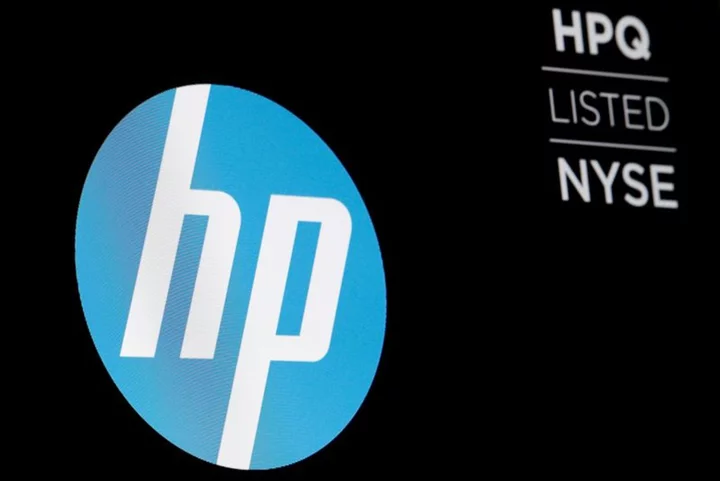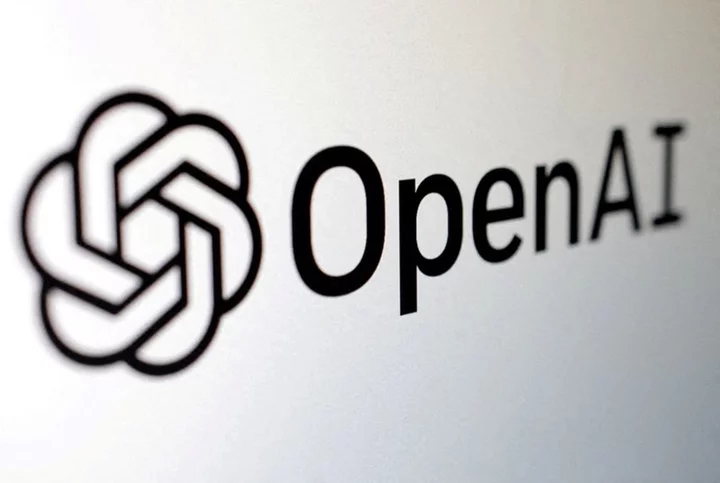
HP forecasts downbeat first-quarter profit amid slow PC market recovery
By Samrhitha A (Reuters) -HP Inc on Tuesday forecast first-quarter profit below Wall Street estimates but maintained annual earnings outlook,
1970-01-01 08:00

Sony facing $7.9 billion mass lawsuit over PlayStation Store prices
LONDON (Reuters) -Sony must face a mass lawsuit worth up to 6.3 billion pounds ($7.9 billion) over claims the PlayStation
1970-01-01 08:00

Blackstone and Permira to buy Adevinta for about $13 billion
Permira and Blackstone on Tuesday said that they willacquire eBay-backed online classifieds group Adevinta ASA for about 141
1970-01-01 08:00

US authorities set to unveil settlement with Binance -source
NEW YORK U.S. government authorities are expected to unveil a settlement with Binance Holdings on Tuesday, resolving a
1970-01-01 08:00

Crypto investors cheer talk of Binance criminal probe resolution
By Tom Wilson and Elizabeth Howcroft LONDON Crypto investors have welcomed the prospect of a resolution of a
1970-01-01 08:00

Broadcom $61 Billion VMWare Deal Wins Chinese Ok With Conditions
Broadcom Inc.’s $61 billion takeover of software maker VMware Inc. won approval from Chinese regulators, albeit with a
1970-01-01 08:00

Earth has just received a message from 10 million miles away
An experiment to see if a laser could beam a message through space to Earth has been successful and could alter the future of spacecraft communication. The experiment was made possible by the Deep Space Optical Communications (DSOC) tool which was travelling onboard NASA’s Psyche spacecraft. It was successfully able to beam a message to Earth, via a near-infrared laser, from far beyond the Moon. It is the furthest such optical communication to have ever been communicated and was encoded with test data to ensure that it worked correctly. The DSOC successfully beamed the data from approximately 16 million kilometers (10 million miles) away to the Hale Telescope at Caltech’s Palomar Observatory in California. Hitching a ride on the Psyche spacecraft, the experiment achieved the so-called “first light” on 14 November, according to NASA's Jet Propulsion Laboratory which is managing the mission from Earth. NASA explained the demo’s “flight laser transceiver – a cutting-edge instrument aboard Psyche capable of sending and receiving near-infrared signals – locked onto a powerful uplink laser beacon transmitted from the Optical Communications Telescope Laboratory at JPL’s Table Mountain Facility near Wrightwood, California.” The uplink beacon assisted the transceiver in aiming its downlink to Caltech’s observatory, where the signal was received. Trudy Kortes, director of Technology Demonstrations at NASA HQ, said: “Achieving first light is one of many critical DSOC milestones in the coming months, paving the way toward higher-data-rate communications capable of sending scientific information, high-definition imagery, and streaming video in support of humanity’s next giant leap: sending humans to Mars.” It’s not the first time that optical communications have been used to beam messages from space, but these laser beams mark the furthest a message has ever been transmitted. With missions further than the moon, NASA typically uses radio waves to communicate. However, laser beams allow for a greater amount of data to be packed in them, potentially giving experts more options in future missions. Dr Jason Mitchell, director of the Advanced Communications and Navigation Technologies Division within NASA’s Space Communications and Navigation program, explained: “Optical communication is a boon for scientists and researchers who always want more from their space missions, and will enable human exploration of deep space.” How to join the indy100's free WhatsApp channel Sign up to our free indy100 weekly newsletter Have your say in our news democracy. Click the upvote icon at the top of the page to help raise this article through the indy100 rankings.
1970-01-01 08:00

Exclusive-OpenAI investors considering suing the board after CEO's abrupt firing -sources
By Anna Tong, Krystal Hu and Jody Godoy (Reuters) -Some investors in OpenAI, makers of ChatGPT, are exploring legal recourse
1970-01-01 08:00

Data protection watchdog warns websites over cookie consent alerts
Some of the UK’s most visited websites face enforcement action from the data protection watchdog if they do not make changes to allow users to consent to advertising cookies. The Information Commissioner’s Office (ICO) said some websites do not give users fair choices over whether or not they are tracked for personalised advertising. The ICO has previously issued guidance to help ensure firms make it as easy for users to reject advertising cookies as it is to accept all – often using consent banners which pop up when a user first lands on a website – but the watchdog has said that some of the UK’s top websites are not complying with data protection law on this issue. Many of the biggest websites have got this right. We’re giving companies who haven’t managed that yet a clear choice: make the changes now, or face the consequences Stephen Almond, ICO It said it had written to a number of firms giving them 30 days to comply or face potential enforcement action. Under UK data protection law, companies must give users fair choice to opt out of tracking using cookies, which is often then used to serve people personalised adverts online. Companies are still able to show users adverts when someone has rejected all tracking, but the ads must not be tailored to the person browsing. Stephen Almond, ICO executive director of regulatory risk, said: “We’ve all been surprised to see adverts online that seem designed specifically for us – an ad for a hotel when you’ve just booked a flight abroad, for instance. Our research shows that many people are concerned about companies using their personal information to target them with ads without their consent. “Gambling addicts may be targeted with betting offers based on their browsing record, women may be targeted with distressing baby adverts shortly after miscarriage and someone exploring their sexuality may be presented with ads that disclose their sexual orientation. “Many of the biggest websites have got this right. We’re giving companies who haven’t managed that yet a clear choice: make the changes now, or face the consequences.” The ICO said it would provide a further update on this work in January, including details of any companies that had not addressed the watchdog’s concerns. Read More Employee data leaked during British Library cyber attack Half of adults who chat online with strangers do not check age – poll Businesses embracing generative AI but fear cyberattacks, survey finds
1970-01-01 08:00

Broadcom plans to close $69 billion VMWare deal on Wednesday
Broadcom said it plans to close its $69 billion deal for cloud computing firm VMWare on Wednesday. Broadcom
1970-01-01 08:00

Chinese rocket that hurtled into the Moon was carrying a ‘secret object’
A mysterious object crashed into the Moon last year, and scientists think they’ve finally figured out what it was. On March 4, 2022, a piece of space junk hurtled towards the surface of our celestial companion, leaving behind not one but two craters – prompting speculation as to what exactly the manmade object was. And now, in a paper published in the Planetary Science Journal, a team of researchers at the University of Arizona (UArizona) have offered “definitive proof” that it was a booster from a Chinese space rocket that had spent several years hurtling through space. But the most interesting part of all this? The defunct piece of spacecraft was apparently carrying a secret cargo. Initially, based on its path through the sky, the UArizona team thought it was an errant SpaceX Falcon 9 rocket booster from a 2015 launch. However, after analysing how precise light signals bounced off its surface, they later concluded that it was more likely to be a booster from a Chang'e 5-T1 – a rocket launched back in 2014 as part of China’s lunar exploration programme. And yet, the Chinese space agency denied ownership, insisting that their rocket booster burned up in the Earth's atmosphere upon re-entry. But the US Space Command refuted this claim by revealing that the rocket’s third stage never re-entered the planet’s atmosphere. Furthermore, two key pieces of evidence gathered by the UArizona researchers suggested that there was more to the object than just a simple abandoned rocket booster. Firstly, the way it reflected light. The paper’s lead author, Tanner Campbell, explained in a statement: "Something that's been in space as long as this is subjected to forces from the Earth's and the moon's gravity and the light from the sun, so you would expect it to wobble a little bit, particularly when you consider that the rocket body is a big empty shell with a heavy engine on one side. “But this was just tumbling end-over-end, in a very stable way." In other words, the rocket booster must have had some kind of counterweight to its two engines, each of which would have weighed around 545kg (1,200lbs) without fuel. The stability with which the object rotated led Campbell and his colleagues to deduce that “there must have been something more mounted to [its] front”. Secondly, the team were struck by the impact the booster left when it slammed into the Moon. It created two craters, around 100ft (30.5 metres) apart, instead of one, which, according to Campbell was very unusual. He pointed out that the craters left behind by Apollo rockets are either round, if the object came straight down, or oblong if it crashed down at a shallow angle. "This is the first time we see a double crater," he said. "We know that in the case of Chang'e 5 T1, its impact was almost straight down, and to get those two craters of about the same size, you need two roughly equal masses that are apart from each other." And yet, despite the rigour of their investigation, the UArizona team have been unable to identify what exactly this additional object was. "We have no idea what it might have been – perhaps some extra support structure, or additional instrumentation, or something else," Campbell admitted. "We probably won't ever know." Sign up for our free Indy100 weekly newsletter Have your say in our news democracy. Click the upvote icon at the top of the page to help raise this article through the indy100 rankings
1970-01-01 08:00

Employee data leaked during British Library cyber attack
A cyber attack targeting the British Library has led to a leak of employee data, the institution said. The Rhysida ransomware group has claimed it has access to passports along with other data files. The group said it has started bidding in an auction for access at 20 bitcoin (around £600,000) on an online site. The British Library, which has one of the largest book collections in the world, previously reported that a “major technology outage” had hit online services, public wifi at the site and its website. Ransomware is the key cyber threat facing the UK, and all organisations should take immediate steps to limit risk by following our advice on how to put in place robust defences to protect their networks National Cyber Security Centre spokesperson It said in October that the National Cyber Security Centre (NCSC) and cybersecurity specialists were investigating. On Tuesday, an NCSC spokesperson said: “We are working with the British Library to fully understand the impact of an incident. “Ransomware is the key cyber threat facing the UK, and all organisations should take immediate steps to limit risk by following our advice on how to put in place robust defences to protect their networks.” The British Library, near St Pancras railway station, remains open and visitors can access the reading rooms for personal study. On Monday, the library posted a statement to X confirming internal HR files had been leaked. It said: “We’re continuing to experience a major technology outage as a result of a cyber-attack, affecting our website, online systems and services, and some onsite services too. “We anticipate restoring many services in the next few weeks, but some disruption may persist for longer. “Following confirmation last week that this was a ransomware attack, we’re aware that some data has been leaked. This appears to be from our internal HR files. “We have no evidence that data of our users has been compromised.” The Information Commissioner’s Office (ICO), the UK’s data protection watchdog, has confirmed it is looking into the breach. An ICO spokesperson said: “The British Library reported an incident to us and we are making inquiries.” Last week, the Federal Bureau of Investigation (FBI), Cybersecurity and Infrastructure Security Agency (CISA), and the Multi-State Information Sharing and Analysis Centre (MS-ISAC) warned about Rhysida. In a joint statement they said the group has launched attacks “against the education, healthcare, manufacturing, information technology, and government sectors since May 2023”.
1970-01-01 08:00
